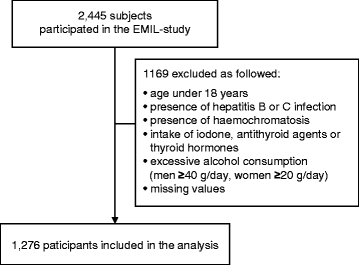Subclinical and clinical hypothyroidism and non-alcoholic fatty liver disease: a cross-sectional study of a random population sample aged 18 to 65 years
- PMID: 26276551
- PMCID: PMC4536732
- DOI: 10.1186/s12902-015-0030-5
Subclinical and clinical hypothyroidism and non-alcoholic fatty liver disease: a cross-sectional study of a random population sample aged 18 to 65 years
Abstract
Background: Non-alcoholic fatty liver disease (NAFLD) is one of the most common disorders of the liver worldwide. Recently, a correlation between thyroid dysfunction and NAFLD has been discussed. Objective of the present study was to investigate the association between thyroid dysfunction and hepatic steatosis.
Methods: Data from 2,445 subjects (51.7% females) aged 18 to 65 years participating in a population-based cross-sectional study were assessed based on a standardized questionnaire and documentation of physical, biochemical and ultrasonographic findings. After application of exclusion criteria, a total of 1,276 subjects were included in the study collective. The influence of potential factors on the development of hepatic steatosis was assessed using multivariate logistic regression.
Results: The prevalence of hepatic steatosis in the study collective was 27.4% (n = 349). The serum thyroxin (TT4) concentration in subjects with hepatic steatosis was reduced (p =0.0004). Adjusting for age, or BMI, there was an increased prevalence of hepatic steatosis in subjects with reduced TT4 concentrations (p = 0.0143; p = < .0001).
Conclusions: The findings of the present study confirm an association between both subclinical and clinical hypothyroidism and hepatic steatosis.
Figures


References
-
- Oh HJ, Kim TH, Sohn YW, Kim YS, Oh YR, Cho EY, et al. Association of serum alanine aminotransferase and gamma-glutamyltransferase levels within the reference range with metabolic syndrome and nonalcoholic fatty liver disease. Korean J Hepatol. 2011;17:27–36. doi: 10.3350/kjhep.2011.17.1.27. - DOI - PMC - PubMed
MeSH terms
Substances
LinkOut - more resources
Full Text Sources
Other Literature Sources
Medical

